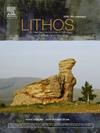Magma through-flow and embedding of magmatic crystals in metasedimentary country rocks adjacent to the Peninsula Granite, Cape Granite Suite (South Africa)
IF 2.9
2区 地球科学
Q2 GEOCHEMISTRY & GEOPHYSICS
引用次数: 0
Abstract
The Sea Point contact in Cape Town, South Africa showcases the interaction between the Malmesbury Group metasedimentary rocks and the intrusive S-type Peninsula Granite of the Cape Granite Suite. The Malmesbury Group, comprising weakly metamorphosed mudstones and siltstones, has been intruded by various granitic injections of varying composition and mineralogical make-up. These granitic injections, displaying diffuse contacts with the country rock and termed “hybrid” granites, indicate varying degrees of assimilation of the country rocks. The injections occurred parallel to the country rock's fabric and anisotropies, particularly along the well-developed S1 foliation. The granites exhibit compositional variations and contain K-feldspar megacrysts in a variable grain-sized groundmass. Some of these megacrysts are found within the Malmesbury Group, with or without quartzofeldspathic material envelopes. Most researchers agree that large K-feldspar megacrysts in granites develop through near-solidus growth, resulting from prolonged exposure to renewed magma input. However, the origin of K-feldspar and other phenocrysts in the adjacent country rocks is debated, with proposed mechanisms including entrapment due to magma through-flow and in situ growth due to K-metasomatism from granitic magma-derived fluids. This study compares the textures and chemistry of K-feldspar megacrysts in various granite types at the Sea Point contact with those in the Malmesbury Group country rock to determine the origin of the latter. The megacrysts in all lithologies show notable textural and compositional similarities, exhibiting poorly defined compositional zoning and consistent variations in K2O, Na2O, and BaO, along with rare earth element concentrations. These attributes suggest that the megacrysts formed through renewed magma injection and prolonged growth involving multiple magma pulses. The study proposes that filter pressing, where melt fractions separate from a crystal mush during crystallisation, occurred during active deformation so that filter pressing was strain-induced. During magma intrusion in a syn- to post-tectonic compressive regime, the melt and associated crystals moved into openings, with the melt fraction more easily mobilised and driven out compared to the crystal fraction during transpression. This left K-feldspar megacrysts embedded or mantled by the country rock. These isolated crystals, with or without associated crystallised magmatic material, mark former magma flow pathways through the country rock, contributing to understanding magma emplacement mechanisms and the formation of the continental crust.

南非开普花岗岩组半岛花岗岩附近的岩浆贯流和变质岩中岩浆晶体的嵌入
南非开普敦的海角接触点展示了马尔梅斯伯里组变质岩与开普花岗岩组的侵入S型半岛花岗岩之间的相互作用。马尔梅斯伯里组由弱变质泥岩和粉砂岩组成,曾被不同成分和矿物组成的各种花岗岩喷入岩侵入。这些花岗岩喷入岩与乡土岩呈弥散接触,被称为 "混合 "花岗岩,表明乡土岩在不同程度上被同化。注入岩与乡村岩的构造和各向异性平行,特别是沿着发达的 S1 叶理。花岗岩呈现出成分变化,在颗粒大小不一的基质中含有钾长石巨晶。其中一些巨晶存在于马姆斯伯里组中,或有或无石英长石包裹体。大多数研究人员一致认为,花岗岩中的大型钾长石巨晶是通过近固结生长形成的,是由于长期暴露于更新的岩浆输入中造成的。然而,对于邻近乡土岩中的钾长石和其他表晶的起源却存在争议,提出的机制包括岩浆贯流导致的夹带以及花岗岩岩浆衍生流体的钾金属气相作用导致的原地生长。本研究比较了海角接触点各种类型花岗岩中的钾长石巨晶与马姆斯伯里组乡村岩中的钾长石巨晶的质地和化学性质,以确定后者的起源。所有岩性中的巨晶在质地和成分上都有明显的相似性,表现出不明确的成分分区,K2O、Na2O 和 BaO 以及稀土元素浓度都有一致的变化。这些特征表明,巨晶是通过岩浆注入和多次岩浆脉冲的长期生长形成的。研究认为,滤压(即在结晶过程中熔体碎片从晶泥中分离出来)发生在活动变形过程中,因此滤压是由应变引起的。在同步构造到后构造压缩机制的岩浆侵入过程中,熔体和相关晶体移动到开口处,与转压过程中的晶体部分相比,熔体部分更容易被移动和驱赶出来。这使得钾长石巨晶嵌入或覆盖在乡土岩中。这些孤立的晶体,无论是否伴有结晶的岩浆物质,都标志着岩浆流经乡村岩石的昔日路径,有助于了解岩浆置换机制和大陆地壳的形成。
本文章由计算机程序翻译,如有差异,请以英文原文为准。
求助全文
约1分钟内获得全文
求助全文
来源期刊

Lithos
地学-地球化学与地球物理
CiteScore
6.80
自引率
11.40%
发文量
286
审稿时长
3.5 months
期刊介绍:
Lithos publishes original research papers on the petrology, geochemistry and petrogenesis of igneous and metamorphic rocks. Papers on mineralogy/mineral physics related to petrology and petrogenetic problems are also welcomed.
 求助内容:
求助内容: 应助结果提醒方式:
应助结果提醒方式:


